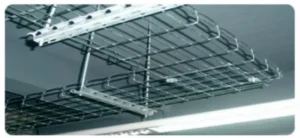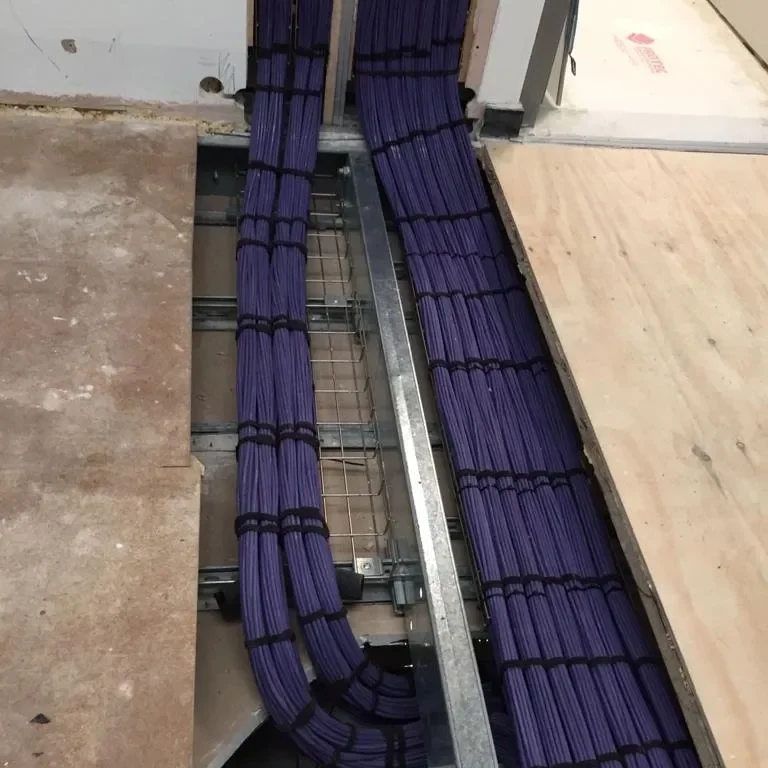Is this now the old fashioned way of running cables?
For some of us there’s nothing nicer than seeing nicely laid bundles of cable. Neat lines, all running parallel, strapped together with zip ties or velcro. Engineers taking pride in their work. However, this could actually be causing your data network problems, and the solution is a lot messier than we’d like it to be…
Copper cable has been providing connectivity to endpoints for decades. The various iterations of Category x cabling standards have given us structure, standardised connectivity, and regulated standards for components and safety. Our endpoints have become ever more demanding, what once was only transmitting 10 or 100 Mbps is now expecting to send and receive 1000 Mbps and potentially 10 Gpbs.
Increasing the amount of data that can be transmitted requires clever use of signalling and frequencies, stuff the standard user doesn’t really need to know about. They just want it to work. The problem is, these higher frequencies induce a phenomenon called cross-talk. A type of interference where the signals from one cable cause undesired effects in another, thus causing issues. In many ways like a crossed line on old fashioned telephone systems, for those of you that can remember that far back, or like several people trying to talk over a walkie-talkie at the same time. The result is an indecipherable mess of noise that the devices connected to it can’t understand. Even with shielded cables, this interference is still possible.
It’s getting hot in here…

Another issue comes with Power over Ethernet (PoE), which many of you will already know is a way of supplying power to devices such as Telephones, WiFi access points, cameras and access control panels, among many other things. As these devices have become smarter their power demands have increased. From an installation and maintenance perspective, PoE makes life a lot easier. No requirements for additional power feeds, no danger of failing power supplies and no extra cabling to difficult to reach areas. The transmission of power along an Ethernet cable generates heat. The heat in a single cable doesn’t really amount to much, but when you start to collect lots of them together, then bunch them up in nice neat, tight bundles, the heat doesn’t have anywhere to escape. There is no free air around the cable for this heat to dissipate into.
When you have a bundle of cables, all supplying power, all producing heat, this has an impact on the conductivity of the cable. A hot cable doesn’t conduct electrical signals as well as a cool cable, introducing more detrimental effects on the information being passed through it.
What’s the fix then?

The answer lies in messy installations. No more neat bundles of cables nicely loomed through the cable trays under the floor, or the cable basket above the false ceiling. The theory is that loose laying cables will reduce the effects of crosstalk by avoiding any two cables running parallel with each other for significant distances, thus reducing the chances of interference. It also allows cables carrying PoE to have more free air around them, helping keep them cool.
By reducing crosstalk, and reducing heat build up, the potential to carry much higher amounts of data can be realised.
So, for those of us that still want to do a neat job, how do we address this?
How do we keep our cables looking good?

It’s all to do with containment. Loose laying directly onto the concrete slab underfloor is a recommended method, as long as cable matting is used to protect the cables from damage. An alternative is cable basket, either above or below floor. With it’s modular design and raised sides, it’s easy to install, provides great support and allows laying of cables without the need to secure them.
In the racks it’s easier to manage cables , the relatively short distances don’t pose an issue. The use of cable sock can neaten appearances and velcro fasteners avoid undue stress in the cable insulation while offering support.
In conclusion, the factors above need to be considered when designing a cabling system for your building. Loose lay cables don’t need to be messy at all, and we can improve network stability and future proofing by adopting this method.
Let Litenet Help you
As an Excel accredited installer of Fibre and Copper cabling solutions, we are well positioned to help you with your structured cabling requirements. If you already have a cable specification in mind we can work to that. If you need help with your design, we can do that too. From racks and panels, to cables and termination boxes, and everything in between. Our cabling solutions have been driving all kinds of businesses including car dealerships, warehousing and logistics, motorsports teams and innovative technology businesses. Get in touch to see how we can help on 01908 794 794 or email info@litenetuk.com



